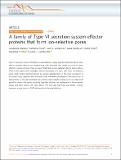Files in this item
A family of Type VI secretion system effector proteins that form ion-selective pores
Item metadata
| dc.contributor.author | Mariano, Giuseppina | |
| dc.contributor.author | Trunk, Katharina | |
| dc.contributor.author | Williams, David J. | |
| dc.contributor.author | Monlezun, Laura | |
| dc.contributor.author | Strah, Henrik | |
| dc.contributor.author | Pitt, Samantha J. | |
| dc.contributor.author | Coulthurst, Sarah J. | |
| dc.date.accessioned | 2019-12-03T11:30:08Z | |
| dc.date.available | 2019-12-03T11:30:08Z | |
| dc.date.issued | 2019-12-02 | |
| dc.identifier | 263044292 | |
| dc.identifier | fd1d434e-7897-4993-aa88-3428ae8976b0 | |
| dc.identifier | 85075953240 | |
| dc.identifier | 000500479300001 | |
| dc.identifier.citation | Mariano , G , Trunk , K , Williams , D J , Monlezun , L , Strah , H , Pitt , S J & Coulthurst , S J 2019 , ' A family of Type VI secretion system effector proteins that form ion-selective pores ' , Nature Communications , vol. 10 , 5484 . https://doi.org/10.1038/s41467-019-13439-0 | en |
| dc.identifier.issn | 2041-1723 | |
| dc.identifier.other | ORCID: /0000-0003-2257-1595/work/65702610 | |
| dc.identifier.uri | https://hdl.handle.net/10023/19048 | |
| dc.description | This work was supported by the Wellcome Trust (104556/Z/14/Z, Senior Fellowship in Basic Biomedical Science to S.J.C.; 097818/Z/11/B and 109118/Z/15/Z, PhD studentships to University of Dundee), the MRC (MR/K000111X/1, New Investigator Research Grant to S.J.C.) and the Royal Society of Edinburgh (Biomedical Personal Research Fellowship to S.J.P.). We thank Roland Freudl for the gift of anti-OmpA antibody; Adam Ostrowski for construction of strains AO07 and AO08; Gal Horesh, Amy Dorward and Gavin Robertson for expert assistance; the Flow Cytometry and Cell Sorting Facility at the University of Dundee; and the Dundee Imaging Facility (supported by Wellcome Trust [097945/B/11/Z] and MRC [MR/K015869/1]) awards). | en |
| dc.description.abstract | Type VI secretion systems (T6SSs) are nanomachines widely used by bacteria to deliver toxic effector proteins directly into neighbouring cells. However, the modes of action of many effectors remain unknown. Here we report that Ssp6, an anti-bacterial effector delivered by a T6SS of the opportunistic pathogen Serratia marcescens, is a toxin that forms ion-selective pores. Ssp6 inhibits bacterial growth by causing depolarisation of the inner membrane in intoxicated cells, together with increased outer membrane permeability. Reconstruction of Ssp6 activity in vitro demonstrates that it forms cation-selective pores. A survey of bacterial genomes reveals that genes encoding Ssp6-like effectors are widespread in Enterobacteriaceae and often linked with T6SS genes. We conclude that Ssp6 and similar proteins represent a new family of T6SS-delivered anti-bacterial effectors. | |
| dc.format.extent | 15 | |
| dc.format.extent | 2065649 | |
| dc.language.iso | eng | |
| dc.relation.ispartof | Nature Communications | en |
| dc.subject | QH426 Genetics | en |
| dc.subject | QR Microbiology | en |
| dc.subject | RB Pathology | en |
| dc.subject | DAS | en |
| dc.subject | BDC | en |
| dc.subject | R2C | en |
| dc.subject.lcc | QH426 | en |
| dc.subject.lcc | QR | en |
| dc.subject.lcc | RB | en |
| dc.title | A family of Type VI secretion system effector proteins that form ion-selective pores | en |
| dc.type | Journal article | en |
| dc.contributor.sponsor | The Royal Society of Edinburgh | en |
| dc.contributor.institution | University of St Andrews. School of Medicine | en |
| dc.contributor.institution | University of St Andrews. Centre for Biophotonics | en |
| dc.contributor.institution | University of St Andrews. Biomedical Sciences Research Complex | en |
| dc.contributor.institution | University of St Andrews. Cellular Medicine Division | en |
| dc.identifier.doi | 10.1038/s41467-019-13439-0 | |
| dc.description.status | Peer reviewed | en |
| dc.identifier.grantnumber | en |
This item appears in the following Collection(s)
Items in the St Andrews Research Repository are protected by copyright, with all rights reserved, unless otherwise indicated.

